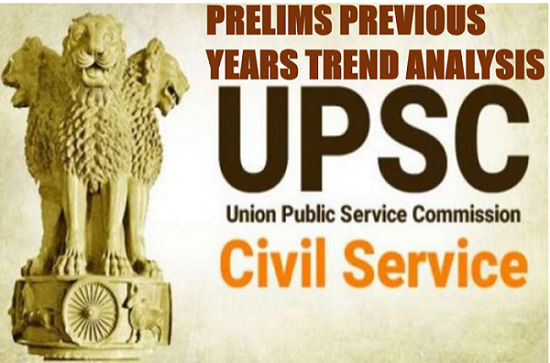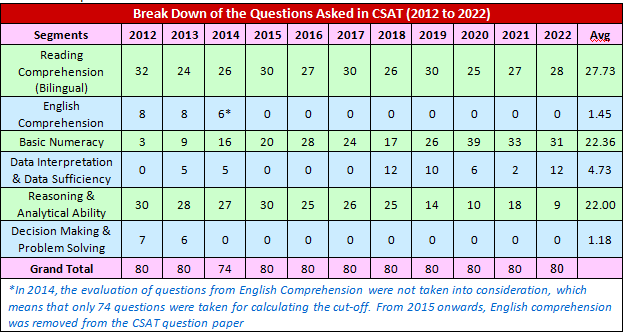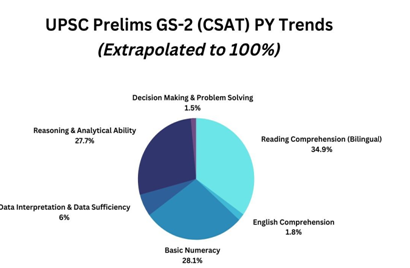
UPSC CSE Prelims Previous Year Papers Analysis helps assess the weightage and the type of questions being asked in the UPSC Exam. The analysis of the UPSC Previous Year Papers is an essential step in the UPSC preparation, as it helps in organizing the systematic efforts to maximize the output. Also, it helps to frame the right UPSC Preparation Strategy.
When the UPSC Prelims paper is analyzed subject-wise, it involves the breakdown of complex topics into simpler and smaller parts. Hence, an aspirant is exposed to the UPSC Exam Pattern and the areas he/she needs to emphasize more on. One can assess his/her strength and weakness in terms of exam preparedness by effective coverage of key concepts that are frequently asked. Through this, the aspirant can restrict his/her preparation according to the UPSC Syllabus and focus on the important aspects, without deviation.
For the UPSC Exam, it is essential to be aware of “What to read and what not to?” The analysis of the UPSC Previous Year Questions helps in doing so!
Here is a Complete UPSC CSE Previous Year Papers Analysis Subject-Wise and Year-Wise.
UPSC Prelims Previous Year Papers [Subject-wise Analysis]
The UPSC Exam preparation is not completed unless the candidate has thoroughly revised and solved the previous year’s question paper and analyzed the different sections according to their importance. Analyzing the topics and sections helps invariably to strengthen the preparation.
Our team has prepared a detailed analysis of the questions asked, as well as their average weightage in the respective exam for the past ten years:

Weight age of Subjects in the Exam Patterns-Prelims-GS-1:
On close examination of the above patterns, following inferences can be drawn;
The subject Indian Economy & Development carries the highest contribution with 17.27% closely followed by History of India with 17.09% contribution.
Collectively the above two subjects contribute 34.36% to the whole of the examination pattern.
The other two subjects Indian Polity & Governance and Environment and Ecology contribute 15.09% each with collective contribution of 30.18%
Current affairs contribute 12.18% closely followed by Indian & World Geography with 12.09% contribution. Collectively these two subjects contribute 24.27%.
Following Diagram shall present the overall pattern at a glance for better understanding;

UPSC CSAT-GS-2 Previous Year Papers Analysis
CSAT Previous Year Paper would play a vital role for all the candidates preparing for UPSC Exam and wishing to qualify the UPSC Prelims in the first attempt. As a serious aspirant knows that the CSAT is the General Studies-II in the UPSC Prelims exam, and it requires candidates to score at least 33% to qualify. Glancing through CSAT Previous Year Paper would guide the candidates to what kind of questions they should expect. Clearing CSAT is extremely important, otherwise, no matter how many marks you secure in the General Studies-I, you won’t be able to clear UPSC Prelims.
CSAT Question Paper carries a total of 200 marks, and candidates need to score at least 66 marks or their General Studies-I paper won’t be evaluated. Candidates can check out the CSAT Previous Year Paper below to understand the examination pattern:

Weight age of Subjects in the Exam Patterns-Prelims-GS-2 (CSAT):
On close examination of the above patterns, following inferences can be drawn;
The subject Reading Comprehension Bilingual carries the highest contribution with 27.73% % closely followed by Basic Numeracy with 22.36% contribution and Reasoning & Analytical Ability with 22% contribution.
Collectively the above three subjects contribute 72.09% to the whole of the examination pattern.
The other two subjects Data Interpretation and Data Sufficiency contributes 4.73% and Decision Making & Problem Solving with 1.18% contribution and collective contribution of 5.91%.
Following Diagram shall present the overall pattern at a glance for better understanding;

The content team at Classic IAS Academy works closely on the past patterns of the UPSC examination so as to design an intelligent and productive course curriculum which would enable the aspirants to crack the examination. The challenge to crack the UPSC exam is also the game of strategy formulation apart from hard work.
We hope that the above analysis shall benefit the UPSC aspirants immensely in preparing their UPSC examination strategy.
our blog on “Careers to be pursued along with Civil Services Exam”

Leave a Reply
You must be logged in to post a comment.